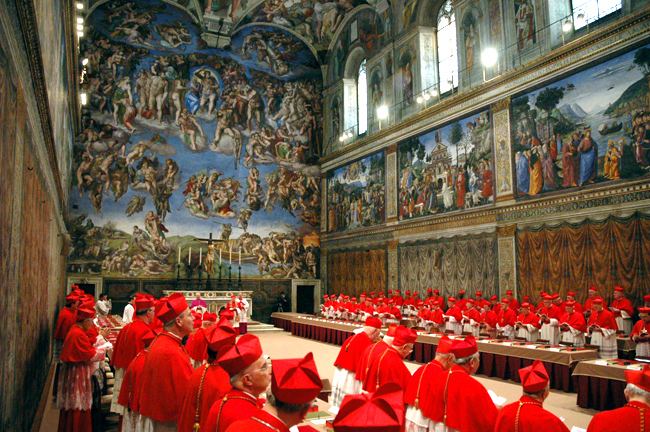Papal Election: A Comprehensive Guide To The Conclave

Table of Contents
The Process Leading to a Papal Election
The election of a new Pope is a meticulously orchestrated process. Understanding its stages provides insight into the weight and significance of this momentous occasion.
Death or Resignation of the Pope
Upon the death or resignation of the Pope, the sede vacante ("the seat is vacant") period begins. This period is marked by a formal announcement and a time of mourning and reflection within the Church. The death of a Pope is typically followed by a nine-day period of mourning before the Conclave begins. The resignation of a Pope, as seen with Pope Benedict XVI, introduces a slightly different timeline, but the essential principle of a vacant papacy remains.
The Role of the College of Cardinals
The College of Cardinals holds the crucial responsibility of electing the next Pope. Its members, chosen by the Pope, are high-ranking clergy from across the globe.
- Eligibility: Cardinals must be under 80 years of age to participate in a Papal Election.
- Number of Cardinals: The number of cardinals varies, but it's typically a substantial body representing diverse regions and theological perspectives.
- Geographical Representation: The College strives for global representation, reflecting the Church's international reach.
Preparation for the Conclave
The summoning of cardinals to Rome marks the commencement of intense preparations. This involves:
- Seclusion: The cardinals enter a period of seclusion within the Vatican, minimizing external influences during the election process.
- Security Measures: Robust security protocols are implemented to ensure the integrity and secrecy of the Conclave.
- Communication Restrictions: Communication with the outside world is strictly limited to maintain the confidentiality of the proceedings. This aspect is crucial to the integrity of the election.
The Conclave Itself: Secrecy and Procedure
The Conclave, held within the Sistine Chapel, is the heart of the Papal Election.
The "Habemus Papam" Moment
The election process involves multiple rounds of voting until a two-thirds majority is achieved.
- Voting Methods: Ballots are cast secretly, and the votes are meticulously counted by appointed officials.
- Two-Thirds Majority Requirement: This threshold ensures a strong consensus among the cardinals.
- Burning of Ballots: After each voting round, ballots are burned. Black smoke signifies a lack of consensus, while white smoke signals the election of a new Pope.
The Significance of the White Smoke
The emergence of white smoke from the Sistine Chapel chimney is a universally recognized symbol. It signifies the culmination of the Conclave and the selection of a new Pope, triggering celebrations worldwide. This visual signal marks a pivotal moment in the history of the Catholic Church.
The Papal Election and Modern Times
While tradition is deeply ingrained, the Papal Election has adapted to modern times.
- Use of Technology: While secrecy remains paramount, some technological advancements have improved efficiency and security.
- Media Coverage: Global media coverage has intensified, with millions following the process through various channels.
- Transparency Aspects: While secrecy around the voting process itself remains central, some aspects of the Conclave's organization have become slightly more transparent.
Understanding the Candidates and their Platforms
The selection of a new Pope involves evaluating various aspects of potential candidates.
Cardinal Profiles
The cardinals consider several factors when voting:
- Theological Perspectives: Alignment with core Church doctrines is paramount.
- Administrative Experience: Proven leadership and management skills are essential to guide the Vatican.
- Pastoral Skills: The ability to connect with people and effectively lead the Church's global flock is crucial.
Pre-Conclave Speculation
Before the Conclave begins, much speculation surrounds potential candidates.
- Influence of Different Cardinal Factions: Different groups of cardinals may have preferences for particular candidates.
- Geographical Considerations: Balancing regional representation is often a factor.
- Pressing Global Issues: The candidates' views on critical global matters such as social justice, environmental concerns, and interfaith dialogue are closely examined.
The Inauguration and Papal Ministry
Following the election, the newly elected Pope is formally inaugurated. This ceremony marks the beginning of his papacy and his responsibilities, which involve leading the Catholic Church globally and acting as a spiritual and moral guide.
Conclusion
The Papal Election, a process rich in history and tradition, is a complex and significant event. Understanding the stages of the Conclave—from the sede vacante period and the role of the College of Cardinals to the voting process, the "Habemus Papam" moment, and the subsequent inauguration—is crucial for appreciating the depth and importance of this event. The selection of a new Pope impacts millions worldwide, shaping the direction of the Catholic Church and influencing global affairs. Understanding the Papal Election process is crucial for navigating the complexities of the Catholic Church. Stay informed about upcoming Papal Elections and the process itself by exploring further resources online.

Featured Posts
-
 Rockets Fall To Warriors Trail 3 1 In Series
May 07, 2025
Rockets Fall To Warriors Trail 3 1 In Series
May 07, 2025 -
 Learn From Buffett Avoiding Errors And Cultivating Humility In Leadership
May 07, 2025
Learn From Buffett Avoiding Errors And Cultivating Humility In Leadership
May 07, 2025 -
 Lotto Lotto Plus 1 Lotto Plus 2 Latest Draw Results And Winning Numbers
May 07, 2025
Lotto Lotto Plus 1 Lotto Plus 2 Latest Draw Results And Winning Numbers
May 07, 2025 -
 Kogda Viydet 7 Sezon Chernogo Zerkala Data Vykhoda 13 Marta 2025 Goda
May 07, 2025
Kogda Viydet 7 Sezon Chernogo Zerkala Data Vykhoda 13 Marta 2025 Goda
May 07, 2025 -
 My Cousin Vinny Reboot Ralph Macchio Provides Update Mentions Joe Pesci
May 07, 2025
My Cousin Vinny Reboot Ralph Macchio Provides Update Mentions Joe Pesci
May 07, 2025
